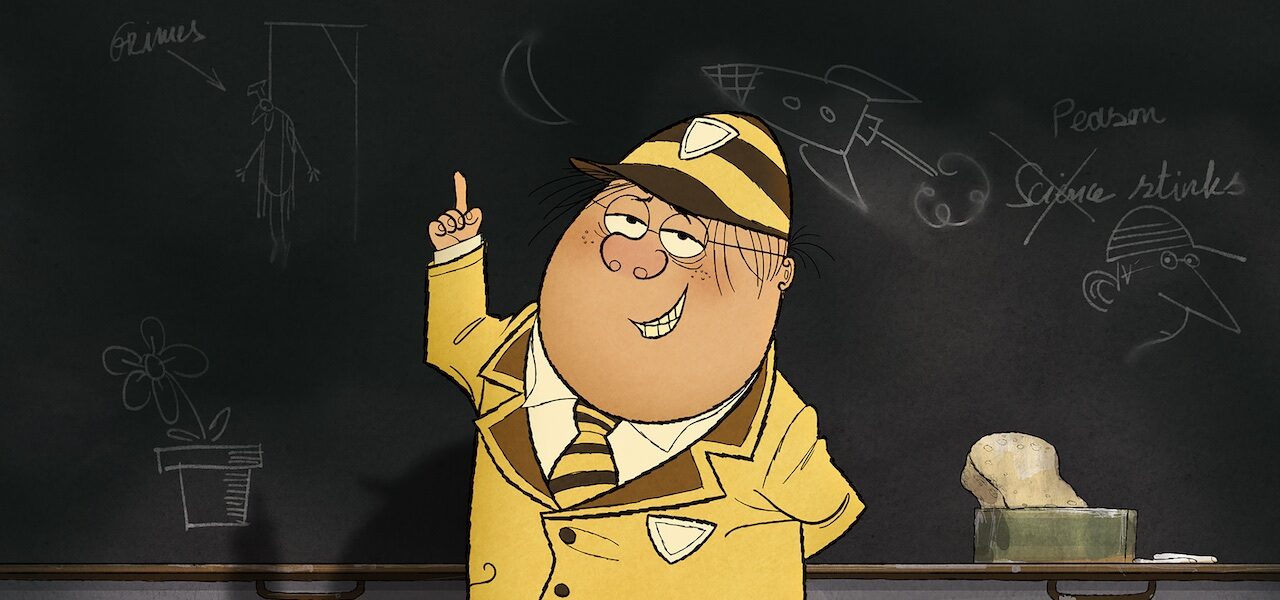
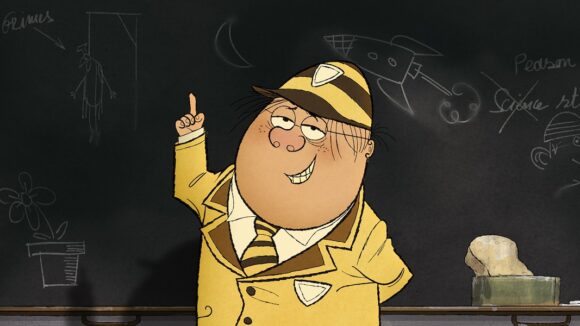
Uli Meyer Is Adapting ‘Molesworth’ Into A Feature (Exclusive Teaser And Interview)
Through the decades, there have been several animated versions of Ronald Searle’s bracingly characterful illustrations — the British cartoonist worked on some of them himself. But on seeing Uli Meyer’s first attempt at adapting his style, Searle decided that only this man could do his characters justice in animation.
Searle died in 2011 — he would have turned 100 yesterday — but Meyer didn’t forget his words. When the chance arose to adapt Molesworth, one of the illustrator’s best-loved works, the director jumped at it. Currently in development, the film was presented today at Cartoon Movie, Europe’s premier pitching forum for animated features (which is taking place in Bordeaux, France). The teaser shown in the presentation has been exclusively shared with Cartoon Brew:
The film is based on the characters of the Molesworth novels, which were written by Geoffrey Willans and illustrated by Searle in the 1950s. Still popular, the books follow the exploits of the titular schoolboy, who lives at the diabolical prep school St Custard’s. They don’t contain linear narratives so much as anecdotal reflections on school life and British society, so Meyer has penned an original story, for a script written by BAFTA-nominated duo Keiron Self and Giles New (Shaun the Sheep).
Leaving his native Germany in the 1980s, Meyer settled in London and swiftly established himself as a character animator of note. Having worked on Who Framed Roger Rabbit, he set up his own company, Uli Meyer Animation, in 1991. By then he was already familiar with Searle’s work, which had been introduced to him by friend Hans Bacher. Years later, Meyer developed a personal relationship with Searle through another friend, industry artist Matt Jones, who runs a blog about Searle in his spare time.
To produce Molesworth, Uli Meyer Studios (as his company is now known) has partnered with Lupus Films, a British animation studio with a strong track record in prestige literary adaptations. Luxembourg’s Melusine Productions is also on board as a co-producer. Camilla Deakin and Ruth Fielding are producing for Lupus, and Stéphan Roelants for Melusine. British comic Matt Lucas (Alice in Wonderland) leads the voice cast as Molesworth.
Ahead of the Cartoon Movie presentation, Cartoon Brew caught up with Meyer and Deakin. We spoke about the challenges of creating “Searlesque” animation, of making a hand-drawn feature today, and of producing British films in the shadow of Brexit.
Why did you decide to adapt Molesworth now?

Meyer: The whole thing started in 2010, when I showed a 20-second St. Trinian’s animation I made to Ronald [watch it below]. I went to visit him in the south of France, and he was really excited about it. He called his agent and said that if I ever wanted to use one of his creations to make a film, I’d have permission to do that. Actually, I’m the only one who has explicit permission from Searle to work with his characters.
I got back to London, and the St. Trinian’s rights were sold in perpetuity to Ealing Studios for live-action versions. Unfortunately, the animation rights were included in that. Eventually, I decided to look at the Molesworth stories, because they were really popular at the time — and still are with some people now. That [was] in 2014.
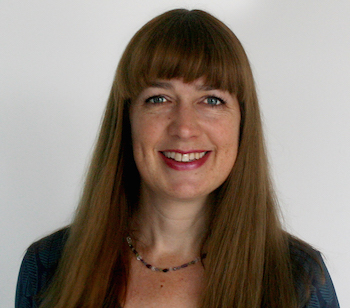
Deakin: We [at Lupus] made a feature film based on Raymond Briggs’s graphic novel Ethel & Ernest. It was the first time in at least a couple of decades that anyone in the U.K. made a 2d hand-drawn feature. Uli got in touch and came to visit the studio, and liked what he saw.
Meyer: Yeah!
Deakin: Our speciality at Lupus is adapting well-known book properties, and when he told me about Molesworth, I immediately got excited, because I’d been a fan of the books since I was young. Having made [Ethel & Ernest, which] was more of an adult movie, I thought how much fun it would be to make a comedy for a family audience.
I also thought it was quite timely, because our success with our tv specials and feature has led us to believe that there’s definitely an audience for traditional animation. Each of our Christmas specials for Channel 4 has been either the highest-rating or among the highest-rating programs of any genre on that channel.
Searle’s characters have been adapted in animation in the past: Energetically Yours, Dick Deadeye. Do you think his style has ever been adapted successfully?
Meyer: In Searle’s own words, he told me he liked the St. Trinian’s test we did. There was a guy called Ivor Wood — he was an animator who did five-second bits of animation [in the 1970s]. He recreated Searle’s style really well. I think Searle was okay with Energetically Yours, but he wasn’t too happy about Dick Deadeye.
I tell you, it’s so difficult to mimic his style, especially in the 1970s, when his penwork became more expressive and experimental. It’s like handwriting. Searle drew all the layouts for Dick Deadeye, then he was a bit disappointed with the animation efforts. On the other hand, it was a low-budget film.
Molesworth is a character from the 1950s, and I think his drawing style from that period is easier to adapt. Having said that, if one person [alone] does a film in a Searle style, you can be more inventive. I had to figure out a way that a whole team could adapt that style.
The Molesworth teaser is not 100% Searle — I call it “Searlesque.” It’s impossible to draw exactly like him, but you can get the essence of the characters, and I figured out an inking procedure that can be adopted by assistants. It needs to look hand-made — I want to avoid as many cg elements as possible.
Will you refer to these earlier films during production on Molesworth?
Meyer: I’ve got a huge collection of original Searle art. My idea is to reference Searle and develop my own version of his world.
What’s fun about adapting his style?
Meyer: I think my own drawing style has always been a little bit Searlesque, and you’re always drawn to artists that you feel close to. Since the first time I saw Searle’s drawings, I felt there was something there that touched [me].
When was the first time?
Meyer: I met Hans Bacher and Harald Siepermann in Düsseldorf in the 1980s. I’d just left school, and we set up a little company called The Mad Tea Party. I was a young kid, earning my money in advertising. Hans had a huge library of Searle books, and that’s when I really got to know his work in detail.
How are you going to adapt his sketchy linework, without it boiling too much?
Meyer: In the teaser, you can obviously see that the line is alive. It’s a mix of it boiling and still being controlled. Searle’s own line is a lot more skimpy, if you want. His drawings are incredibly structured. What’s underneath all this wild, scratchy ink line is really well-constructed shapes. I think if you were to do an entire film frame by frame, and it boiled too much, I don’t think you could sit through it. So I had to find a way to mimic [his style] and make it not too wild.
Will you be working entirely on tablets?
Meyer: I made the St. Trinian’s test on frosted cel with a nib and ink. I then did another test on TVPaint, and compared both, and you couldn’t see any difference. We’re planning to do [Molesworth] all on tablets — I don’t think you could find a big enough crew who could handle frosted cels and ink tracing. The teaser was drawn in TVPaint. We’ve used a lot of textures that were hand-painted, hand-drawn, to create backgrounds. All the characters and layouts were drawn digitally.
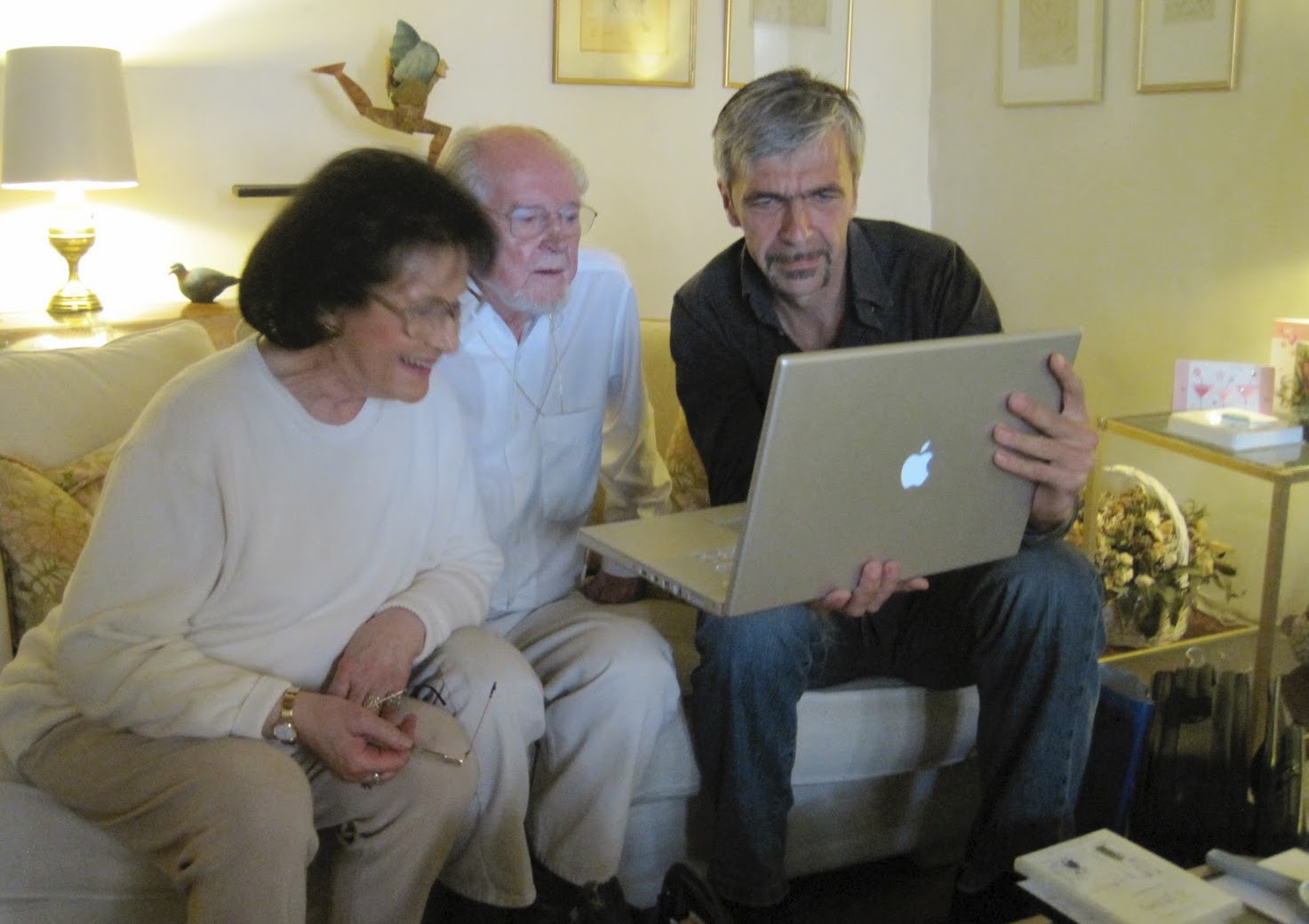
How easy is it to find the crew for a 2d feature nowadays? I was recently speaking to the Klaus team, who said that they couldn’t find many layout artists.
Deakin: It’s funny you should say that, because we had a similar problem with [the 2019 tv special] The Tiger Who Came to Tea. But we’ve got one or two really, really good layout artists. It’s just that people with those skills have suddenly become more in demand.
We crewed up successfully for Ethel & Ernest, and we make all our half-hour specials entirely in-house. We have a full team of 50 or 60 animators working across about nine months. The talent is out there — the challenge is more: are there lots of other 2d films about to crew up at the same time?
Because there are quite a few films made in Ireland, France, Spain, increasingly in traditional 2d, and quite often in TVPaint. The very top-flight 2d animators that have feature-quality skills are in demand, and tend to be a fairly mobile workforce — or they work from home.
Meyer: I’ve got lots of friends in animation all over the planet. I’d have a wish list of animators who I’d love to work on this film, and I know a lot of them want to. I think there’s a lot of new, amazing talent out there, especially on Klaus. I think there’s a 2d revival: if you’re very good at it, you can still have a career.
Deakin: I’d agree with that. When we did Ethel & Ernest, we had a bit of a shortage. So we reached out to all the animation schools in the U.K. that had 2d courses, and set up some training with ScreenSkills[’s Animation Skills Council]. We trained them up in TVPaint, and I have to say that some of the people who came up through those schemes are now among the best animators in the industry.
Camilla, you said that you noticed there’s a real appetite for traditional animation. But a feature is quite a different proposition from a tv special, and Molesworth is only your second. Apart from the skills shortage, what are the challenges of making a feature like this in the U.K.?
Deakin: We’ve actually got another film, Kensuke’s Kingdom, which is in pre-production. That will go ahead of Molesworth. The challenge is raising finance in a rapidly shifting market, because, while there’s still a big appetite for family films, there’s a bit of uncertainty about how many low-to-medium-budget animated films can be successful at the box office, with such a lot of audience going over to watching films on SVOD platforms.
But I don’t think there’s less demand. The British Film Institute did a study on the most successful British movies at the box office, and I think it was family films that came out on top. We’ve come across a lot of research that says that, actually, in the current climate of children spending more time at home, family co-viewing is really on the rise. Friday movie night: get a pizza and watch a film with your mom and dad. It’s a thing the SVOD platforms are definitely aware of.
Equally, I don’t think the demand for family films in school holidays is going down. So I think it’s a good time to be making animated family features. The challenge is always the same: a European independent animated film would probably cost less in live action, so you have to be very robust about the commercial case for it when you’re going to financiers.
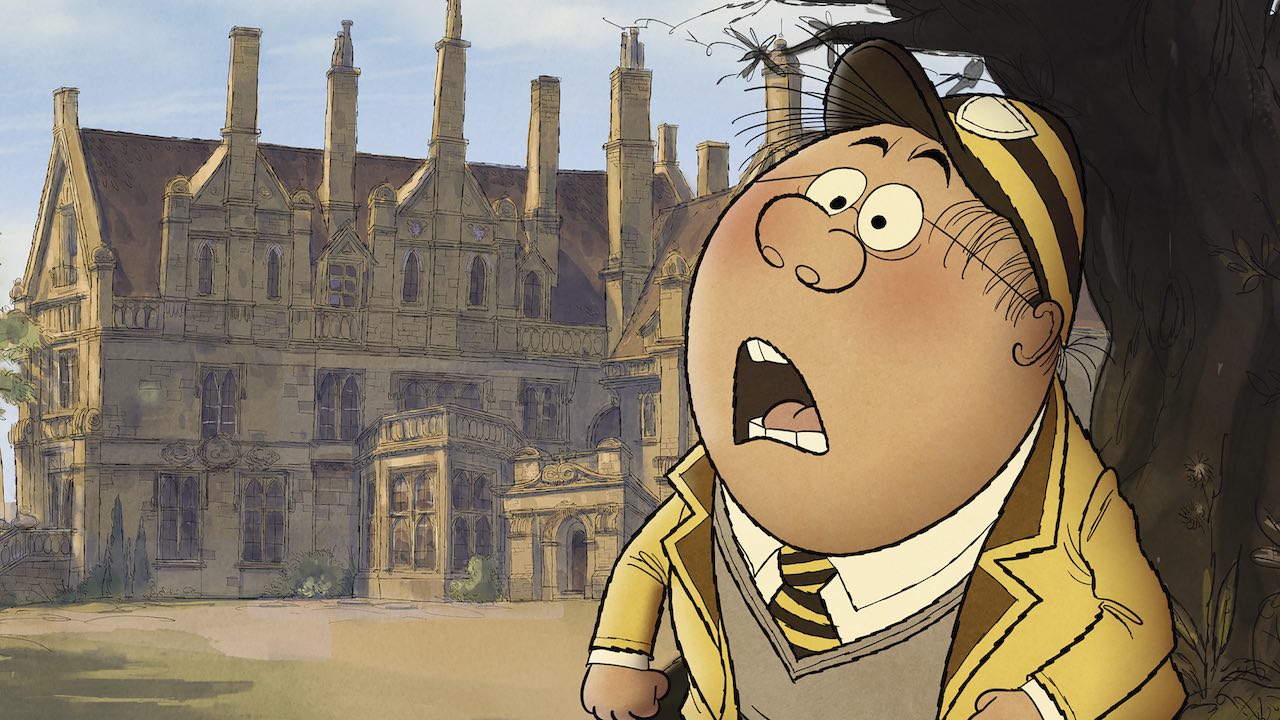
To what extent has Brexit changed your approach to Molesworth?
Deakin: It hasn’t really changed our approach to development. I’m glad to say that some of our regular co-producers, such as Melusine in Luxembourg — Brexit doesn’t affect their ability to co-produce with us. [The U.K. is] still part of the European Economic Area. We may not be in the European Union, but we’re still able to co-produce with whomever we like.
I think some other countries are a bit more cautious about co-producing with the U.K. But the biggest difference for us is probably not being in the E.U. Media [funding] program. We still don’t quite know what’s happening there. I think that, technically, we’re out… [Editor’s note: after the interview was conducted, it was confirmed that the U.K. will not seek to continue participating in the program from 2021.] We’ve been very, very grateful recipients of E.U. Media funding for some of our development projects, including Molesworth.
Also, for production, [Brexit is] going to be problematic. Because the animators we work with are a very international bunch, and we’ve always had a large cohort of animators from continental Europe. Now, that’s going to give us a bit of a headache, because we’re going to have to arrange and pay for visas… So, from our perspective, Brexit is a bad thing. But at the same time, we’re producers, so by nature we’re tenacious.
You’ve described your Molesworth adaptation as being “adjusted to today’s family audiences in tone and pace.” What does this mean?
Meyer: From my point of view, I want to stick as much as possible to the characters in the original book. It’s set in postwar London in the early 1950s. We’re not introducing kids on mobile phones; we’re not transporting the story into today. It’s more [about] how you tell the story in film and animation: the pacing will probably be different than [in] a 1950s film. The visuals might, although based on Searle’s designs, be more adapted to today’s viewing.
Deakin: I’d also add that we’ve got a fantastic couple of screenwriters, Keiron Self and Giles New, who work a lot in comedy. They’re both actors and writers, and work in animation and live action. They brought a comedy sensibility to it which I think works well for today’s audience. They’ve taken all the essential elements from the Molesworth books and written a really funny, gag-dense script.
The thing about the Molesworth books is they’re not narrative stories. They’re a kind of how-to guide — how to survive school. They never had a story with a beginning, middle, and end, so we had to invent one.
Uli, you spoke to Cartoon Brew a while back about MonsterMania, a feature you were trying to get off the ground. What did you learn from the experience that you can bring to this project?
Meyer: [Laughs] Yeah. When I opened my company, we quickly became one of the biggest studios in London. We worked on high-end commercials, with Disney on The Lion King, with Warner Bros. on Space Jam. So all the projects I personally developed were very, very ambitious.
Very often, we came close to moving further [on MonsterMania]. But… I would probably now start smaller… My thing is the creative side and not so much the business side. The people I teamed up with at the time were making promises they couldn’t keep, and so on and so forth. But this is all hindsight, 20/20 vision.
When I met Camilla and we talked, it just felt right to team up with Lupus Films for Molesworth. Even just making the teaser was so much fun. Adapting Searle is just great fun to do.
